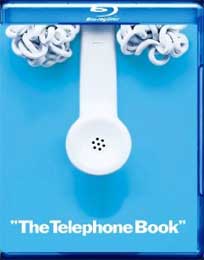 THE
TELEPHONE BOOK (1971) Blu-ray/DVD combo
THE
TELEPHONE BOOK (1971) Blu-ray/DVD comboDirector: Nelson Lyon
Vinegar Syndrome
 THE
TELEPHONE BOOK (1971) Blu-ray/DVD combo
THE
TELEPHONE BOOK (1971) Blu-ray/DVD comboSarah Kennedy (Stephanie Rothman’s THE WORKING GIRLS) falls in love with “the world’s most obscene phone call” in THE TELEPHONE BOOK, rediscovered and restored on Blu-ray/DVD combo by Vinegar Syndrome.
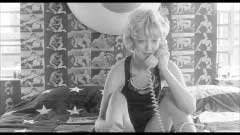
Alice’s (Kennedy) daily routine of nude exercising and calling Dial-A-Prayer is pleasantly upset when she receives an orgasmic obscene phone call from a John Smith (voice over artist Norman Rose) who claims to have perfected the “art”. Determined to find him, she takes to the phone book to track him down via the telephone book but she is constantly waylaid by seemingly upstanding middle class citizens with bizarre sexual kinks. Her episodic journey includes an audition for former stag film actor (Barry Morse, THE FUGITIVE) staging a comeback under the name “Har Poon”, a psychoanalyst (Roger C. Carmel, BREEZY) who orgasmically dispenses coins from a belt coin changer as she submits to analysis and tells him the story of her encounter with a man (William Hickey, PRIZZI’S HONOR), a cackling mugger (Matthew Tobin), and a lesbian (Jan Farrand) who invites her into her home to use the phone only to assault her with several vibrators. Will Alice ever experience "the world's most obscene phone call" or is her trip down the rabbit hole all about the journey?
 Virtually
forgotten after its unsuccessful theatrical release and reissue (more about
that later), THE TELEPHONE BOOK was one of the last American mainstream X-rated
films before the classification became synonymous with DEEP THROAT and the subsequent
theatrical hardcore porn boom (when Columbia Pictures released EMMANUELLE in
1974, their ad campaign emphasized that “X was never like this”).
The film was the brainchild of motion picture adman Merwin Bloch and writer
Nelson Lyon who had worked together on major ad campaigns for MGM, Paramount
and United Artists. Bloch initially signed actress Geneviève Waïte
for the lead since she had previously starred in the swinging 1960s pic JOANNA
(out on DVD and Blu-ray in the UK as part of BFI’s Flipside series), but
her husband at the time – John Phillips of The Mamas & The Papas –
did not want her to do it. Bloch subsequently auditioned Diane Keaton (who would
not do nudity), Jill Clyburgh (who would do nudity but was wrong for the role
and was instead given a smaller part as Alice’s friend who is either contemplating
killing her husband or herself), and LOLITA’s Sue Lyon (who was also wrong
for the part) before seeing Sarah Kennedy in a soft drink commercial. Andy Warhol
liked the script and – in addition to supplying Ondine as an intermittent
onscreen narrator and Ultra Violet as a whip-wielding dominatrix at Har Poon’s
orgy (which also includes an appearance by a German Shepherd trained by Captain
Haggerty [Lucio Fulci’s ZOMBIE] who later appears as the district attorney
– agreed to appear in a thirty-second intermission scene that ended up
cut for pacing (which Bloch now admits was his biggest marketing mistake). Initially
budgeted at under $200,000, the budget ballooned to $400,000 thanks to the usual
litany of problems on independent and mainstream films (including not budgeting
for cocaine, as Bloch admits in the commentary). The original ending had to
be scrapped when weather ruined the shot, and a new ending was conceived intercutting
animation (to visualize the obscene phone call) by cartoonist Len Glasser with
color footage. To break up the monotony of Mr. Smith’s monlogues, Lyon
scripted a series of confessionals from obscene phone callers including Dolph
Sweet (the dad on the Nell Carter sitcom GIMME A BREAK) and the usually schoolmarm-ish
Lucy Lee Flippin (LADY IN WHITE) as a housewife with a shocking banana fetish.
Virtually
forgotten after its unsuccessful theatrical release and reissue (more about
that later), THE TELEPHONE BOOK was one of the last American mainstream X-rated
films before the classification became synonymous with DEEP THROAT and the subsequent
theatrical hardcore porn boom (when Columbia Pictures released EMMANUELLE in
1974, their ad campaign emphasized that “X was never like this”).
The film was the brainchild of motion picture adman Merwin Bloch and writer
Nelson Lyon who had worked together on major ad campaigns for MGM, Paramount
and United Artists. Bloch initially signed actress Geneviève Waïte
for the lead since she had previously starred in the swinging 1960s pic JOANNA
(out on DVD and Blu-ray in the UK as part of BFI’s Flipside series), but
her husband at the time – John Phillips of The Mamas & The Papas –
did not want her to do it. Bloch subsequently auditioned Diane Keaton (who would
not do nudity), Jill Clyburgh (who would do nudity but was wrong for the role
and was instead given a smaller part as Alice’s friend who is either contemplating
killing her husband or herself), and LOLITA’s Sue Lyon (who was also wrong
for the part) before seeing Sarah Kennedy in a soft drink commercial. Andy Warhol
liked the script and – in addition to supplying Ondine as an intermittent
onscreen narrator and Ultra Violet as a whip-wielding dominatrix at Har Poon’s
orgy (which also includes an appearance by a German Shepherd trained by Captain
Haggerty [Lucio Fulci’s ZOMBIE] who later appears as the district attorney
– agreed to appear in a thirty-second intermission scene that ended up
cut for pacing (which Bloch now admits was his biggest marketing mistake). Initially
budgeted at under $200,000, the budget ballooned to $400,000 thanks to the usual
litany of problems on independent and mainstream films (including not budgeting
for cocaine, as Bloch admits in the commentary). The original ending had to
be scrapped when weather ruined the shot, and a new ending was conceived intercutting
animation (to visualize the obscene phone call) by cartoonist Len Glasser with
color footage. To break up the monotony of Mr. Smith’s monlogues, Lyon
scripted a series of confessionals from obscene phone callers including Dolph
Sweet (the dad on the Nell Carter sitcom GIMME A BREAK) and the usually schoolmarm-ish
Lucy Lee Flippin (LADY IN WHITE) as a housewife with a shocking banana fetish.
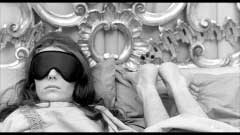
Hugh Hefner was initially interested in distributing the film to launch his company Playboy Productions but eventually turned it down in favor of Roman Polanski’s MACBETH. Bloch took the film to Los Angeles to screen it for MGM, United Artists, and National General Pictures before it was eventually picked up by Joseph Levine’s Avco Embassy who released it under a dummy company called Rosebud Releasing Corporation (when Dino De Laurentis took over Embassy, he also used Rosebud Releasing Corporation to release EVIL DEAD II unrated). The film could not find a market as art house or comedy, and the neither the distributor nor the credits saw the air of melancholy underlying the absurdity: that the obscene phone callers are outwardly normal-seeming people suggests that Lyon believed that it isn’t people who are perverted but the outlets for sexual expression. In contrast, the sexually savvy Alice’s apartment is littered with skin magazines and wallpapered with pornographic images (chosen by Bloch from Screw Magazine); yet when her best friend won’t let her use her phone and asks Alice why she doesn’t use the phone in her own apartment, she tells her “If I spend too much time there, I start trying to kill myself” (just as her sexual openness horrifies the perverted psychoanalyst, it may have alienated her from many of her friends). Levine subsequently sublicensed the film to Allen Shackleton’s Monarch Releasing retitling it as HOT NUMBER and hoping for the same kind of marketing success the company achieved with SNUFF. It proved too cerebral for the raincoat audience as well and did not find its cult audience until it began circulating as a bootleg VHS (likely derived from the Australian Embassy VHS) and then overseas in 2008 as a revival and DVD release in conjunction with a pair of German entrepreneurs and Bloch. While it may indeed find another cult niche domestically with Vinegar Syndrome’s Blu-ray and DVD release – as well as, presumably their DCP master available for theatrical screening – it is also the odd one out amidst the company’s more exploitation-oriented releases thus far (although their upcoming release of Marvin J. Chomsky’s GOOD LUCK MISS WYCKOFF suggests a broadening of the company’s catalog). It certainly improves with viewing, seeming less juvenile and more misanthropic. It also helps to recognize the familiar faces as working actors or then-unknowns.
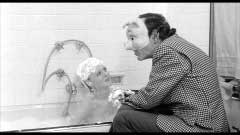 The
German DVD was transferred in fullscreen – mostly open matte, but slightly
punched in compared to Vinegar Syndrome’s widescreen transfer –
from a print that was missing a few bits that had to be inserted from an inferior
video master. Vinegar Syndrome’s single-layer Blu-ray and dual-layer DVD
are mastered from a 2K transfer – framed at exactly 1.85:1 – of
a 35mm print that is not pristine but gorgeous nonetheless. The monochrome photography
is faithfully rendered (the look of the film was inspired by Jean-Luc Godard’s
BREATHLESS and Bloch and Lyon wanted Raoul Coutard to shoot the film but he
couldn’t get a permit to work in the States), detail is superb (Ondine
either has dandruff or plaster dust on his shoulders), and the fine patterns
of horrid 1970s jackets are without distortion. The color sequence at the end
has some shots that are grainier than others, but the fault might lie with the
original photography since other shots in the same sequence are much cleaner
and the animation is also in great condition apart from some light scratches.
The mono track is encoded on both discs in Dolby Digital 2.0 and is problem
free (the song heard over the main and end titles is supposed to be warbly).
The
German DVD was transferred in fullscreen – mostly open matte, but slightly
punched in compared to Vinegar Syndrome’s widescreen transfer –
from a print that was missing a few bits that had to be inserted from an inferior
video master. Vinegar Syndrome’s single-layer Blu-ray and dual-layer DVD
are mastered from a 2K transfer – framed at exactly 1.85:1 – of
a 35mm print that is not pristine but gorgeous nonetheless. The monochrome photography
is faithfully rendered (the look of the film was inspired by Jean-Luc Godard’s
BREATHLESS and Bloch and Lyon wanted Raoul Coutard to shoot the film but he
couldn’t get a permit to work in the States), detail is superb (Ondine
either has dandruff or plaster dust on his shoulders), and the fine patterns
of horrid 1970s jackets are without distortion. The color sequence at the end
has some shots that are grainier than others, but the fault might lie with the
original photography since other shots in the same sequence are much cleaner
and the animation is also in great condition apart from some light scratches.
The mono track is encoded on both discs in Dolby Digital 2.0 and is problem
free (the song heard over the main and end titles is supposed to be warbly).
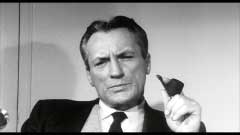
While producer Merwin Bloch recorded a commentary for the German release, Vinegar Syndrome has recorded a brand new one moderated by Joe Rubin (for whom we also have to thank for tracking down a complete good quality 35mm print). Rubin is not only an obsessive fan of the film but also well-informed about Bloch’s impressive career as a motion picture adman (working with MGM, Paramount and United Artists). The first 18 minutes of the commentary make scant reference to the onscreen action while covering in detail Bloch’s career which includes such highlights as collaborating with Stanley Kubrick on the advertising campaign for 2001, directing Roman Polanski in footage shot (by Sven Nykvist) exclusively for the trailer for THE TENANT, directing Orson Welles in a voiceover for the STAR TREK feature film trailer, creating the poster for RAGING BULL, working on the advertising and trailers for several Woody Allen films (he also had small roles in HUSBANDS AND WIVES and CRIMES AND MISDEMEANORS) and constructing the trailer for William Friedkin’s CRUISING exclusively from stills since the director would not release any footage (he is also responsible for THE TELEPHONE BOOK’s phallic dangling phone poster artwork). Bloch had little to say about director Nelson Lyon on the previous track; but that was perhaps because Lyon was still alive at the time (Lyon died in 2012). Here he reveals that Lyon – nicknamed “Captain Smut” for his obsession with pornography – worked with him on studio campaigns and then freelance when Bloch founded his own company Rosebud. He laments that Lyon’s career as a director was derailed by the failure of this film – although he admits that he gave Lyon the job of directing because he wrote it and that he was soon out of his depth – and that his subsequent career as a comedy writer for Saturday Night Live was cut short by his involvement in the three-day drug binge that killed John Belushi which got him effectively blacklisted on both coasts.
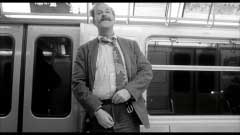 Bloch
repeats some anecdotes from the German track such as giving away the pornographic
wallpaper to the crew because the printer had printed up so much extra (on this
track, he adds that he deliberately chose less explicit images from Screw
Magazine to go for an R-rating but the ending animation cemented the X-rating).
On both tracks he speaks reverently of voice actor Norman Rose (known as “the
voice of god”) and was saddened to learn that Rose lost two of his biggest
accounts (the US Army and AT&T) as a result of appearing in the film. On
both tracks, he reveals that Morse wanted to do his scene nude but settled on
funny boxer shorts, but reveals here that Flippin came up with the banana bit
herself. I don’t recall hearing it on the new track, but he mentioned
on the older track that a few of Alice’s phone exchanges with Mr. Smith
are subtitled for his dialogue not as an artistic conceit but because Rose wasn’t
available. Having failed to get Coutard to shoot the film, Bloch ended up with
Leon Perera who had worked under Gordon Willis (THE GODFATHER) and Michael Chapman
(RAGING BULL). New to the Vinegar Syndrome track is the story of how Bloch won
an eBay auction for a suitcase containing Perera’s camera notes and some
35mm clips from THE TELEPHONE BOOK. Also new – I believe – is the
anecdote about Ralph Bakshi asking Leonard Glasser to screen the last reel of
the film and then storming off in anger upon discovering that Glasser’s
sequence preceded FRITZ THE CAT as the first mainstream X-rated piece of animation.
Bloch ends his contribution to the track with an anecdote about waiting for
the first reviews in the morning paper just tables away from Peter Bogdanovich
and Jack Nicholson who were waiting to hear the critical reception to THE LAST
PICTURE SHOW. Rubin briefly discusses the film’s recovery and restoration
but does not go into much detail.
Bloch
repeats some anecdotes from the German track such as giving away the pornographic
wallpaper to the crew because the printer had printed up so much extra (on this
track, he adds that he deliberately chose less explicit images from Screw
Magazine to go for an R-rating but the ending animation cemented the X-rating).
On both tracks he speaks reverently of voice actor Norman Rose (known as “the
voice of god”) and was saddened to learn that Rose lost two of his biggest
accounts (the US Army and AT&T) as a result of appearing in the film. On
both tracks, he reveals that Morse wanted to do his scene nude but settled on
funny boxer shorts, but reveals here that Flippin came up with the banana bit
herself. I don’t recall hearing it on the new track, but he mentioned
on the older track that a few of Alice’s phone exchanges with Mr. Smith
are subtitled for his dialogue not as an artistic conceit but because Rose wasn’t
available. Having failed to get Coutard to shoot the film, Bloch ended up with
Leon Perera who had worked under Gordon Willis (THE GODFATHER) and Michael Chapman
(RAGING BULL). New to the Vinegar Syndrome track is the story of how Bloch won
an eBay auction for a suitcase containing Perera’s camera notes and some
35mm clips from THE TELEPHONE BOOK. Also new – I believe – is the
anecdote about Ralph Bakshi asking Leonard Glasser to screen the last reel of
the film and then storming off in anger upon discovering that Glasser’s
sequence preceded FRITZ THE CAT as the first mainstream X-rated piece of animation.
Bloch ends his contribution to the track with an anecdote about waiting for
the first reviews in the morning paper just tables away from Peter Bogdanovich
and Jack Nicholson who were waiting to hear the critical reception to THE LAST
PICTURE SHOW. Rubin briefly discusses the film’s recovery and restoration
but does not go into much detail.
 Besides
the brief original trailer (0:38) directed by Bloch himself, the Blu-ray and
DVD also include the rarer HOT NUMBER reissue trailer (2:05) which takes advantage
of the film’s X-rating to make heavy use of the animated sequences. The
black and white footage in the trailer is tinted (presumably the feature itself
was never tinted since Bloch says that Levine provided Shackleton with a handful
of prints into which the new title was spliced). Also included is a still gallery
that features press materials and behind the scenes photos, including a shot
of Kennedy wielding a knife (which Rubin and Bloch reveal was from a longer
version of the lesbian scene that was trimmed because the third participant
– who appears nowhere in the finished cut – was “lousy”
and the scene went on too long) as well as a photograph of Andy Warhol on set.
The gallery ends with newspaper clipping showing an ad for THE TELEPHONE BOOK
alongside Bogdanovich’s THE LAST PICTURE SHOW. Vinegar Syndrome’s
disc closes its extras out with a selection of radio spots (3:32) while the
German release included a longer selection, as well as 15 soundtrack cues, and
a bilingual booklet (THE TELEPHONE BOOK is the first of Vinegar Syndrome’s
Blu-ray/DVD combos to not feature a booklet). Fans – well maybe fanatics
– might want to seek out the import (which initially sold for 49 euros
and is likely now out of print since the company’s Facebook page for the
film hasn’t been updated since 2010) but Vinegar Syndrome’s release
should more than suffice with the superior transfer and new commentary. (Eric
Cotenas)
Besides
the brief original trailer (0:38) directed by Bloch himself, the Blu-ray and
DVD also include the rarer HOT NUMBER reissue trailer (2:05) which takes advantage
of the film’s X-rating to make heavy use of the animated sequences. The
black and white footage in the trailer is tinted (presumably the feature itself
was never tinted since Bloch says that Levine provided Shackleton with a handful
of prints into which the new title was spliced). Also included is a still gallery
that features press materials and behind the scenes photos, including a shot
of Kennedy wielding a knife (which Rubin and Bloch reveal was from a longer
version of the lesbian scene that was trimmed because the third participant
– who appears nowhere in the finished cut – was “lousy”
and the scene went on too long) as well as a photograph of Andy Warhol on set.
The gallery ends with newspaper clipping showing an ad for THE TELEPHONE BOOK
alongside Bogdanovich’s THE LAST PICTURE SHOW. Vinegar Syndrome’s
disc closes its extras out with a selection of radio spots (3:32) while the
German release included a longer selection, as well as 15 soundtrack cues, and
a bilingual booklet (THE TELEPHONE BOOK is the first of Vinegar Syndrome’s
Blu-ray/DVD combos to not feature a booklet). Fans – well maybe fanatics
– might want to seek out the import (which initially sold for 49 euros
and is likely now out of print since the company’s Facebook page for the
film hasn’t been updated since 2010) but Vinegar Syndrome’s release
should more than suffice with the superior transfer and new commentary. (Eric
Cotenas)